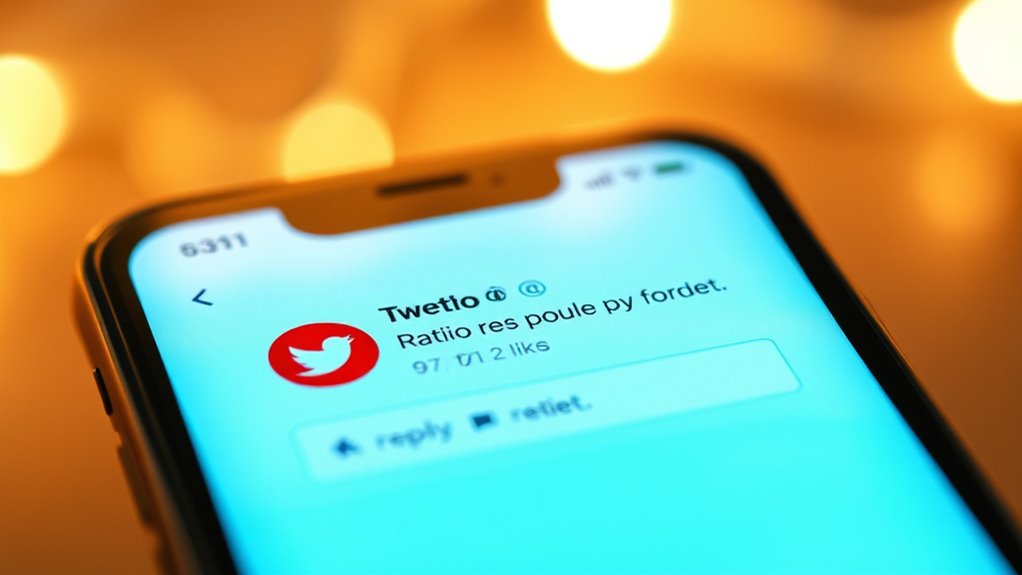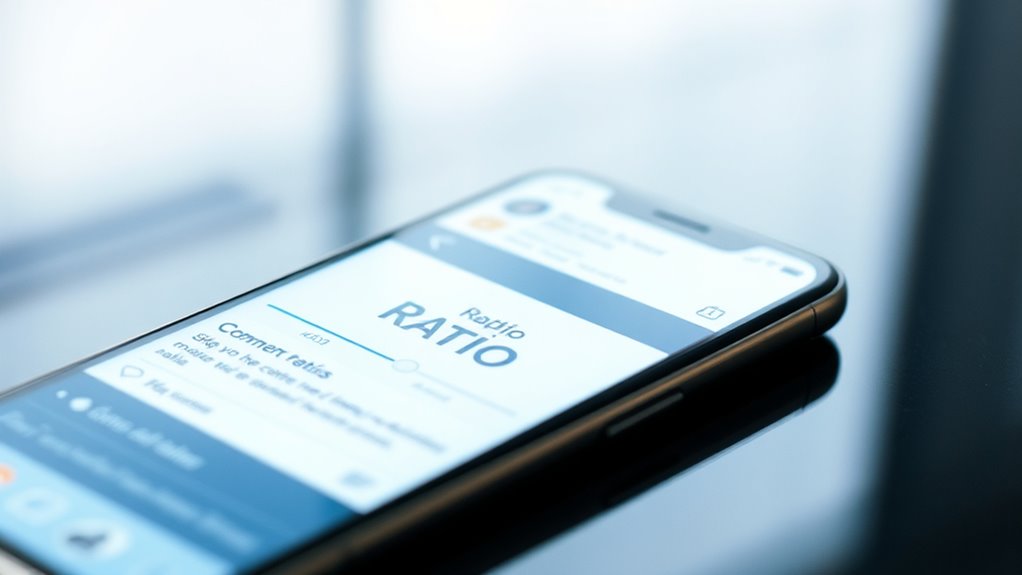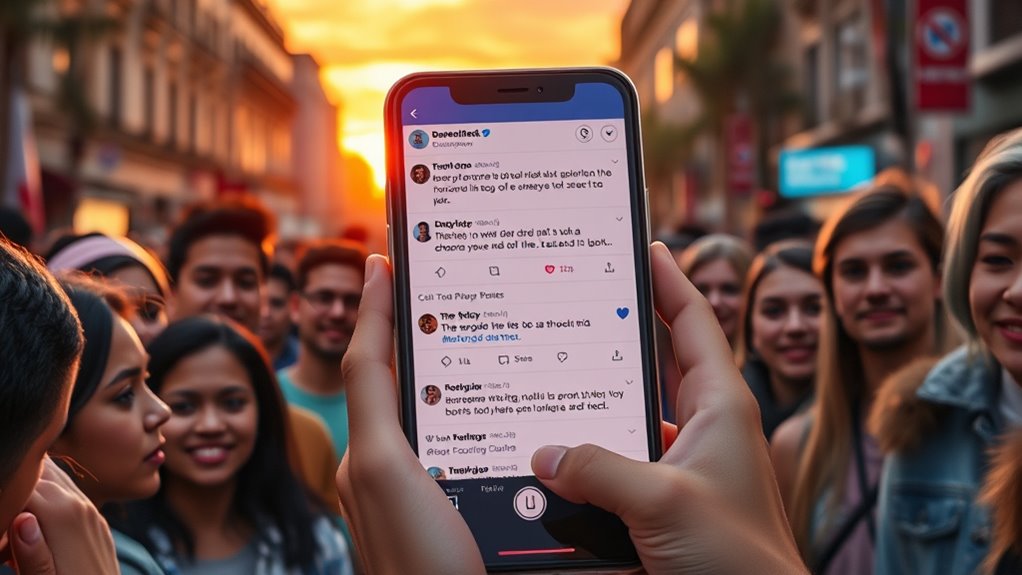On X or Twitter, “ratio” happens when a post gets many replies compared to likes or retweets, signaling disagreement or controversy. It shows that people often challenge or criticize the content, sometimes going viral for the wrong reasons. A heavy ratio indicates potential backlash, while a balanced one suggests support. To understand the nuances and why certain posts get ratioed, stick around—you’ll learn more about the social dynamics behind these interactions.
Key Takeaways
- “Ratio” on X/Twitter refers to when a post has significantly more replies than likes or retweets.
- It indicates public disagreement, controversy, or criticism toward the original content.
- A high reply-to-like/retweet ratio signals negative reactions or backlash.
- Ratios often become viral, influencing perceptions and sparking debates.
- The term helps gauge community sentiment and the overall response to a tweet.
The Origin of the Term “Ratio” on Social Media

The term “ratio” on social media originated from the way users react to a tweet or post that receives disproportionately more replies than likes or retweets. When you notice a post with a high reply count, it often signals disagreement or controversy, making it a part of viral trends. These trends spread quickly because of social influence, where people observe the reactions of others and respond accordingly. The “ratio” became a way to measure public sentiment, highlighting posts that attract significant attention for the wrong reasons. It’s a reflection of how social influence shapes online conversations, with users collectively shaping perceptions through their reactions. Additionally, understanding audience engagement can help explain why certain posts go viral or become “ratioed,” as users are motivated to participate in trending discussions. This origin story shows how social media reactions can quickly turn into trending topics that influence wider online discourse.
How “Ratio” Is Calculated on X/Twitter

To understand how “ratio” is calculated on X/Twitter, you need to look at the relationship between replies, likes, and retweets a post receives. Typically, a high reply count compared to likes and retweets indicates a negative response, signaling a poor user engagement score. Here’s how it works:
A high reply-to-like and retweet ratio signals a negative or critical response.
- Count the number of replies a tweet gets.
- Check the number of likes it receives.
- Note the retweets it garners.
- Compare these numbers to see if replies outnumber likes and retweets considerably.
- The context of engagement metrics helps interpret whether a tweet is resonating positively or negatively with viewers.
A heavily ratioed tweet often sparks viral trends, but it also shows that many users are engaging critically or dismissively. This calculation helps you quickly gauge whether a post resonates positively or negatively with viewers.
The Significance of a Heavily Ratios Tweet

Ever wonder what a heavily ratioed tweet really signals? It often indicates strong community influence or disagreement. When a tweet gets ratioed, it signals a viral trend or debate that captures attention. Such tweets can sway opinions or spark conversations across the platform. They highlight how community members respond to content, revealing what resonates or triggers backlash. A heavily ratioed tweet can serve as a barometer of public sentiment, shaping future discussions. Additionally, the public perception of a post can be significantly affected by how the community reacts to it.
Examples of Different Types of Ratios and Their Meanings

You’ll notice that some ratios reflect positive engagement, like when a tweet gets many likes and retweets relative to comments. Others indicate negative responses, such as when replies outweigh the original post and likes combined. Understanding these different ratios helps you interpret how audiences react to content more accurately. For example, a high number of negative reactions may suggest controversy or dissatisfaction with the content.
Positive Engagement Ratios
Positive engagement ratios on X/Twitter measure how well a post resonates with its audience by comparing likes, retweets, or replies to views or impressions. High ratios often signal viral trends and strong influencer metrics, boosting your visibility. To better understand, consider these examples:
- An engagement ratio of 10% suggests your content is highly appealing.
- A 5% ratio indicates moderate interest but room for growth.
- Ratios below 1% may signal the need to refine your approach.
- Exceptional ratios often lead to increased exposure and follower gains.
- Understanding contrast ratio helps in optimizing visual content for better engagement.
Negative Response Indicators
Negative response indicators on X/Twitter reveal how audiences react unfavorably to your content, often signaling disapproval or disengagement. When your tweet receives more replies or quote tweets than likes or retweets, it suggests a negative user reaction. This is common with viral trends that spark controversy or disagreement. If your ratio shows a high number of replies compared to retweets, it indicates that users are engaging critically or dismissively. Similarly, a low ratio of likes to comments can signal disapproval or frustration. These ratios act as clear negative response indicators, helping you understand when your content doesn’t resonate or sparks backlash. Recognizing these patterns allows you to gauge audience sentiment and adjust your approach accordingly.
How to Identify a “Ratioed” Post in Your Feed

To spot a ratioed post in your feed, start by checking the reply count—if it’s considerably higher than the likes or retweets, that’s a red flag. Next, compare the engagement ratio to the overall post activity; a low ratio indicates many users are commenting negatively or dismissively. Paying attention to these signs helps you quickly identify when a post is getting ratioed. Additionally, understanding the Forsale 100 context can sometimes shed light on trending discussions or controversies around the content.
Look at Reply Count
Ever wonder how to spot a “ratioed” post on your feed? Check the reply count, as it’s a key indicator. A high reply count compared to likes and retweets suggests a disconnect between the post and the audience. Here are four ways to identify a ratio:
- Notice if replies vastly outnumber likes and retweets.
- Look for comments that criticize or challenge the original tweet.
- Observe if the reply count keeps climbing quickly after posting.
- Compare reply count to the engagement ratio; a high reply count often signals a “ratioed” post.
- Understanding the 16PF traits behind audience reactions can provide deeper insights into the social dynamics at play.
Check Engagement Ratio
How can you tell if a post is “ratioed” just by looking at its engagement? Check the engagement ratio, which compares replies, retweets, and likes to the original post. A high reply count relative to other interactions often indicates a “ratioed” post, especially if it sparks viral trends or heated community engagement. If a tweet has many replies but relatively few likes or retweets, it suggests the community is pushing back or disagreeing. This imbalance signals that the post’s message is controversial or unpopular. Monitoring engagement ratios helps you quickly identify posts that have become “ratioed,” giving insight into what sparks debate and how community engagement shapes viral trends on X/Twitter. Analyzing engagement ratios also involves understanding cookie categories that can influence the visibility of content and user interactions.
The Impact of Ratioing on User Reputation and Engagement

Have you noticed that when your tweet gets ratioed, it often sparks more attention than positive interactions? This can remarkably impact your reputation and engagement. Here’s how:
- It draws eyes to your account, increasing your visibility during viral trends.
- It can boost or harm your perceived user influence, depending on public perception.
- It often leads to more replies, retweets, and followers—either positively or negatively.
- It may shape how others view your credibility, affecting future interactions.
- Understanding the personality traits associated with social media responses can help you interpret and respond to ratios more effectively.
While a ratio might seem negative, it can also elevate your profile if handled wisely. Understanding this impact helps you navigate the social landscape, leverage viral trends, and build or repair your reputation on X/Twitter.
Common Reasons Why Posts Get Ratios

Posts often get ratioed when they trigger strong emotional reactions or touch on controversial topics. This usually happens because people feel compelled to voice their opinions, especially if a post relates to viral phenomena or hot-button issues. When a tweet sparks widespread disagreement or ridicule, users may reply in large numbers, leading to a high reply-to-like ratio. Additionally, meme evolution plays a role—what starts as a simple joke can quickly turn into a widespread critique, prompting others to respond critically. If your post is perceived as insensitive, inaccurate, or out of touch, it’s more likely to be ratioed as people push back. Essentially, posts that tap into collective feelings or trending topics tend to attract more engagement, often resulting in a ratio. Understanding social dynamics can also help explain why certain posts go viral and attract disproportionate responses.
Differences Between a Ratio and Other Forms of Feedback

A ratio on X/Twitter specifically measures the imbalance between replies and likes a post receives, often indicating disagreement or criticism. Unlike simple likes, which show approval, a high reply count suggests controversy. This differs from other feedback forms, like retweets or shares, which spread content without judgment. To clarify:
- Likes show support, while ratios often signal backlash.
- Retweets amplify viral trends but don’t imply approval.
- Comments can be positive or negative, but ratios highlight negative sentiment.
- Memes often go viral, but when ratioed, they can reveal meme culture’s critique or satire.
- Recognizing these social signals is essential for understanding content engagement and the overall sentiment behind trending topics and viral memes, revealing whether a post is genuinely popular or met with criticism.
Strategies for Responding to a Ratioed Post

When you see a post that’s been ratioed, start by analyzing the comment thread to understand the main concerns or criticisms. Then, craft a respectful response that addresses valid points without escalating the situation. This approach helps you respond thoughtfully and maintain credibility online. Additionally, understanding the context of the conversation can help you formulate a more appropriate response.
Analyze the Comment Thread
Handling a ratioed post can be tricky, but understanding how to analyze the comment thread helps you gauge public opinion and refine your response. Start by observing the tone—are commenters supportive, dismissive, or critical? Next, look for patterns in engagement metrics, like common concerns or misconceptions. Third, identify influential commenters whose opinions sway others, shaping viral trends. Finally, consider whether the comments reveal genuine feedback or just noise. This analysis helps you decide whether to engage, clarify, or step back. Additionally, recognizing the horsepower or performance expectations in responses can guide your tone and messaging. By carefully evaluating the comment thread, you can better understand the post’s impact and tailor your future responses accordingly, turning a ratio into an opportunity rather than a setback.
Craft a Respectful Response
Responding respectfully to a ratioed post can turn a potentially negative situation into an opportunity for constructive dialogue. In online communication, maintaining good online etiquette is essential, even when you disagree with or want to clarify a ratioed comment. Keep your tone calm and respectful, avoiding personal attacks or inflammatory language. Address the core issue politely, providing evidence or reasoning if needed, rather than engaging in arguments. Remember, a thoughtful, respectful response can encourage others to consider your perspective and help de-escalate tension. By approaching the situation with civility and clarity, you demonstrate maturity in digital communication and foster a more positive online environment. This respectful approach not only reflects well on you but also encourages healthier interactions on social media platforms.
The Cultural and Social Implications of “Ratio” on X

Have you ever noticed how the term “ratio” on X/Twitter has become more than just a social media metric? It reflects cultural and social shifts, influencing online humor and social validation. When someone gets ratioed, it often signals public disapproval, shaping perceptions about humor and opinions. Here’s what it reveals:
- It highlights the power of social validation, where a high reply-to-like ratio signals widespread agreement or disagreement.
- It influences online humor, as users craft jokes that either avoid or provoke ratioing to gain attention.
- It fosters a social hierarchy, where being ratioed can diminish credibility.
- It encourages users to adapt their tone, knowing their replies can be scrutinized for cultural implications.
- The concept of energetic alignment can also be seen in how users align their responses to resonate with or challenge prevailing sentiments.
Ultimately, “ratio” shapes how we communicate and judge social norms on X.
Frequently Asked Questions
Can a Post Be “Ratioed” Without Receiving Many Replies?
Yes, a post can be “ratioed” without many replies, because engagement metrics like likes and retweets also play a role. If your post receives markedly more comments than likes or retweets, it signals low social influence, indicating a ratio. This imbalance suggests people disagree or want to criticize, even if the number of replies isn’t high. So, yes, a post can be ratioed without many replies, based on engagement metrics alone.
Does “Ratio” Always Mean a Negative Reaction?
Like Icarus soaring too close to the sun, you might think a ratio always signals a negative reaction, but it’s more complex. A ratio reflects public opinion and viral metrics—sometimes highlighting controversy, other times sparking curiosity or support. So, no, a ratio doesn’t always mean backlash; it’s a gauge of engagement, revealing how your content resonates, whether positively or negatively in the vast landscape of social media.
How Does the “Ratio” Differ From a Simple Like or Retweet?
The “ratio” differs from a simple like or retweet because it measures engagement metrics beyond positive social signaling. When your tweet gets more replies than likes or retweets, it indicates a potential disagreement or negative reaction. Unlike likes or retweets, which boost visibility, the ratio signals how your message resonates negatively, giving you insight into audience sentiment and the broader social response to your content.
Is “Ratio” an Official Feature or Just Slang?
Like a badge of honor, “ratio” isn’t an official feature but social media slang that signals online engagement. When your tweet gets more replies than likes or retweets, it’s “getting ratioed,” often implying disagreement or criticism. This quick term captures how users gauge a post’s popularity or controversy, making it a handy shorthand in digital conversations. So, you won’t find “ratio” in Twitter’s settings, but it’s widely understood across the platform.
Can a Post Be “Ratioed” by a Specific Group or User?
Yes, a post can be “ratioed” by a specific group or user, affecting its engagement metrics and social influence. When a particular audience or influential user replies or criticizes your post, it can lead to a high number of replies and less likes or retweets, signaling a poor ratio. This dynamic can impact how others perceive your social influence, often making your content seem less favorable or controversial.
Conclusion
Now that you know what “ratio” really means on X, you can spot a ratioed tweet in a heartbeat. It’s a quick way to see if your post hits the mark or ruffles feathers. Remember, understanding the vibe behind the ratio helps you avoid flying off the handle. So, stay sharp, keep your eyes peeled, and don’t let the ratio catch you off guard—after all, it’s all part of the social media game.









